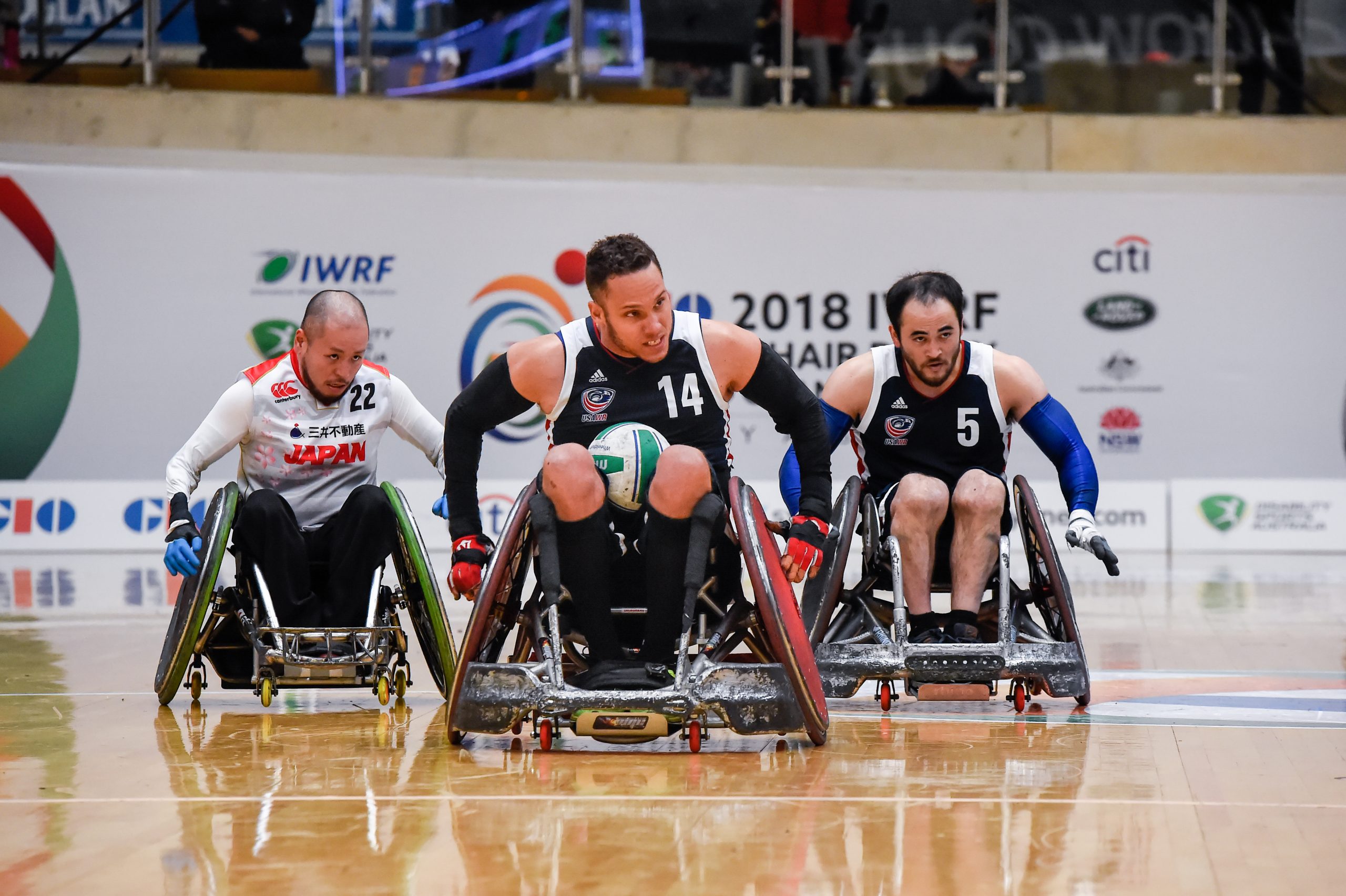
Wheelchair Rugby
Trying to describe the sport of wheelchair rugby may be difficult. You just have to see it. Better yet, you just have to play it.
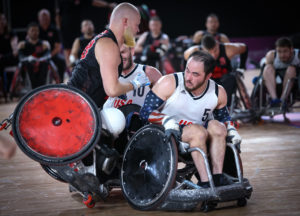 “There really isn’t an able-bodied counterpart,” according to Katie Joly, program manager at the Gaylord Hospital Sports Association, a Move United member organization based in Connecticut. “It is a mixture of rugby, soccer, handball, and even a little bit of basketball in there.”
“There really isn’t an able-bodied counterpart,” according to Katie Joly, program manager at the Gaylord Hospital Sports Association, a Move United member organization based in Connecticut. “It is a mixture of rugby, soccer, handball, and even a little bit of basketball in there.”
Something you should know right from the start. Wheelchair rugby is definitely a contact sport, which is what draws players to the game. James Gumbert, head coach for the USA Wheelchair Rugby Team, was a player before he got into coaching. “I knew from the moment I jumped into a competition chair and rolled out onto the court the very first time, that this was the sport for me. It was something I had been missing since I’d been injured,” Gumbert said.
“Some of the athletes who get into the sport have a daredevil mentality,” Gumbert said. “They’ve enjoyed living on the edge. That feeling doesn’t go away after you get injured, it is still inside you. You still yearn for that adrenaline rush, that sense of freedom, and that sense of being alive again.”
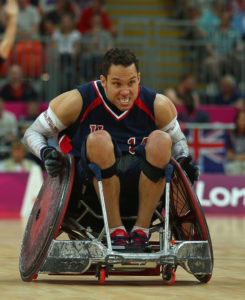 As a contact sport, expect some collisions. Because it is a contact sport, please note that a physician clearance may be required to play. It is because of this though, that the sport is so appealing to those who play. Take Team USA Player Chuck Melton, for example. Reluctantly, Melton went to a practice in St. Louis but hasn’t looked back since. “I started pushing and took a couple hits, and fell in love with it right away,” he said. “It is like a demolition derby on a basketball court with a volleyball.”
As a contact sport, expect some collisions. Because it is a contact sport, please note that a physician clearance may be required to play. It is because of this though, that the sport is so appealing to those who play. Take Team USA Player Chuck Melton, for example. Reluctantly, Melton went to a practice in St. Louis but hasn’t looked back since. “I started pushing and took a couple hits, and fell in love with it right away,” he said. “It is like a demolition derby on a basketball court with a volleyball.”
The collisions may be a draw, but so is the camaraderie. “I got more out of the first few practices in talking with other players about how they adjusted with their disability than anything else,” Melton said. “I started to realize there were more things out there than feeling sorry for yourself.”
Joe Delagrave, who has played for Team USA for 13 seasons and has served as co-captain, agrees. “I love being part of a team, being a part of a group striving for something bigger than myself,” he said. “It’s a support group.”
WHAT You Need to Know
Wheelchair rugby is played on a basketball court with the regulation size of 94 feet x 47 feet. It is four on four, with four players per team on the court at one time. All players have a point classification assigned to them based on their disability, ranging from .5 for someone with lower amounts of function to 3.5 for someone who may have more function (in .5 increments) and each team cannot have more than 8 points on the court. “You try to put the best matchup and mix from the squad you have,” Gumbert said. The sport is co-ed, with female athletes getting an additional half point deduction on their classification.
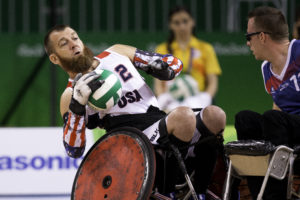 The object of the game is to take the ball (a volleyball) and advance it from one end of the court to the other end. You have to bounce or pass the ball every 10 seconds. You might find some rules that are similar to basketball. For example, you have a 40-second clock and must score within that timeframe or it is a turnover. You have some common fouls that might apply in the game of hockey, where you may have to serve in the penalty box if you’ve committed one.
The object of the game is to take the ball (a volleyball) and advance it from one end of the court to the other end. You have to bounce or pass the ball every 10 seconds. You might find some rules that are similar to basketball. For example, you have a 40-second clock and must score within that timeframe or it is a turnover. You have some common fouls that might apply in the game of hockey, where you may have to serve in the penalty box if you’ve committed one.
Two cones, 24 feet apart, make up the goal line. A team earns a point, or try, if you go over the baseline with any two wheels while having possession of the ball. Anyone can score, but some players may focus on offense or defense.
Games are 32 minutes in length (four 8-minute quarters), but typically lasts 1 ½ hour in total time after you factor in the stop and go clock, the 10-minute halftime, and time outs.
It is a fast action, up and down the court kind of game. “Strong athletes can push from one end to another in about 5.5 seconds,” Gumbert said. “That equates to up to 15-20 miles an hour, so when there is a collision, you see it and you hear it.” Each team can score 50-60 points per game.
EQUIPMENT Needed
 Obviously, the main piece of equipment every player needs in order to play wheelchair rugby is a sport chair. Most local teams, like Gaylord, have program chairs that players can use at the beginning. It is important to get properly fitted into a chair. “Having the right chair that fits the player is critical to an individual player’s success,” Joly said. “The chair is part of your body. When you are moving, you want it to stay with you.”
Obviously, the main piece of equipment every player needs in order to play wheelchair rugby is a sport chair. Most local teams, like Gaylord, have program chairs that players can use at the beginning. It is important to get properly fitted into a chair. “Having the right chair that fits the player is critical to an individual player’s success,” Joly said. “The chair is part of your body. When you are moving, you want it to stay with you.”
Chairs do have straps and belts to secure players in, which could include a lap belt, foot belt, or chest strap to keep you in your chair.
After a year or two of playing the game, Joly recommends getting a customized chair, important if you want to progress in the sport. “Everything is customized to the player. The chairs are custom to different sizes, shapes, and heights. Players may prefer different push rims, camber, or center of gravity.”
Gumbert suggests you should mold into the chair. “The chair is built to both give and absorb impact,” he said. It is for this reason that it is a relatively safe sport. “The most common injury we have typically involves the hands,” he said. “Do people flip over? Yes.”
He also has another philosophy when it comes to the chair: “You should see the chair as a way to play the sport and not as something you are confined to.”
TAKING It to the Next Level
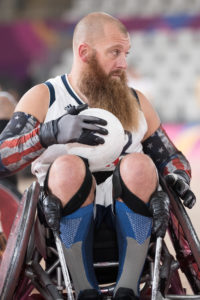 To compete in the sport, players should work on cardio and build endurance. “You stop and go, but you do that continuously for an hour and a half, so it is an aerobic sport,” Gumbert said. He suggests you can get in 12-15 miles on the court during practice or camp.
To compete in the sport, players should work on cardio and build endurance. “You stop and go, but you do that continuously for an hour and a half, so it is an aerobic sport,” Gumbert said. He suggests you can get in 12-15 miles on the court during practice or camp.
Once you’ve determined that wheelchair rugby is the sport for you, find a local club team to join. There are three divisions at the club level. Division 1 is the top competitive level, so there is a difference in play between each division. Of course, you can always try out for the national team, which is headquartered at the Lakeshore Foundation, a Move United member based in Birmingham, Alabama, (learn more at usawr.org).
FIND A Program
Delagrave went to his first wheelchair rugby practice in 2006 at the Courage Kenny Rehabilitation Institute, a Move United member organization in Minneapolis, Minnesota, and fell in love with the sport. “I was terrible at it, but realized that I can do a sport. I was breathing heavy and my lungs were getting full of air. I felt like an athlete again.”
According to Delagrave, sports are a great way to figure out how to become more independent. “You can become very dependent on others and take that victim mentality and think woe is me, I can’t do this or can’t do that. But for many of us, we choose that victor card. We realize we can do this. It may be hard, but I’ll figure it out.”
There’s a place at the table for everyone in the sport, according to Gumbert. “Everyone should be able to experience the same rush and the joy that sports bring, whether you want to play professionally or just want to get out and have fun. There’s more to the sport than just winning gold medals and trophies. The sport really does change lives,” he said. But he is also quick to point out: “At the end of the day, sport is sport. There is a winner and loser. We’re not playing for hugs; we’re playing to win.”


